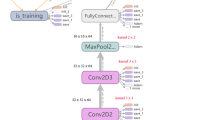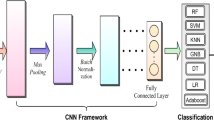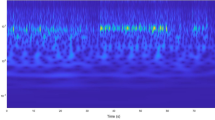Abstract
This study presents a computer-aided diagnosis (CAD) system that uses deep learning to diagnose migraine from electroencephalogram (EEG) signals. The proposed method converts EEG signals into scalogram images using the continuous wavelet transform method. Afterward, these scalogram images were given as input to the proposed convolutional neural network (CNN) deep learning network. With the proposed CNN deep learning model, 100% classification success has been achieved with very high accuracy compared to other related literature studies. Comparative analyses of the classification success of the proposed method and the classification performances obtained using state-of-the-art CNN models (VGG16, DenseNet121, ResNET101, and Xception) are presented. It has been observed that this study is superior to state-of-the-art CNN deep learning models compared with low computational complexity, simple network structure (less depth), and high classification performance. In addition, interpretable Gradient-weighted Class Activation Mapping (GradCAM) images were obtained to support the specialist in the diagnosis of migraine. In the study, it is revealed that there is a relationship between EEG recordings and migraine disease in terms of frequency components. When interpretable GradCAM images are examined, it is seen that mid- and high-frequency components are essential in distinguishing between migraine and healthy individuals. Considering the mentioned aspects, it is seen that this study has the potential to be used as a CAD system that can contribute to the expert opinion in distinguishing migraine patients and healthy controls.









Similar content being viewed by others
Availability of Data and Material
The data used in this study are taken from the publicly available data set. The data set is available at "https://kilthub.cmu.edu/articles/dataset/Ultra_highdensity_EEG_recording_of_interictal_migraine_ and controls_sensory_and_rest/12636731" [13].
References
H. Abbasi, A.J. Gunn, C.P. Unsworth, L. Bennet, Advanced deep learning spectroscopy of scalogram infused CNN classifiers for robust identification of post-hypoxic epileptiform EEG spikes. Adv. Intell. Syst. 3, 2000198 (2021). https://doi.org/10.1002/aisy.202000198
H. Akbari, S. Ghofrani, P. Zakalvand, M.T. Sadiq, Schizophrenia recognition based on the phase space dynamic of EEG signals and graphical features. Biomed. Signal Process. Control 69, 102917 (2021). https://doi.org/10.1016/j.bspc.2021.102917
S.B. Akben, A. Subasi, D. Tuncel, Analysis of repetitive flash stimulation frequencies and record periods to detect migraine using artificial neural network. J. Med. Syst. 36, 925–931 (2012). https://doi.org/10.1007/s10916-010-9556-2
S.B. Akben, D. Tuncel, A. Alkan, Classification of multi-channel EEG signals for migraine detection. Biomed. Res. 27, 743–748 (2016)
Z. Aslan, On the use of deep learning methods on medical images. Int. J. Energy Eng. Sci. 3, 1–15 (2019)
Z. Aslan, Migraine detection from EEG signals using tunable Q-factor wavelet transform and ensemble learning techniques. Phys. Eng. Sci. Med. (2021). https://doi.org/10.1007/s13246-021-01055-6
Z. Aslan, An Empirical Mode Decomposition approach for automated diagnosis of migraine. Biomed. Signal Process. Control 73, 103413 (2022). https://doi.org/10.1016/j.bspc.2021.103413
Z. Aslan, M. Akin, A comparison of heuristic search algorithms for automatic schizophrenia detection, in 4th International Energy & Engineering Congress (2019), pp. 1248–1258.
Z. Aslan, M. Akin, Automatic detection of schizophrenia by applying deep learning over spectrogram images of EEG signals. Traitement Du Signal (2020). https://doi.org/10.18280/ts.370209
R.J. Barry, A.R. Clarke, Resting state brain oscillations and symptom profiles in attention deficit/hyperactivity disorder, in Supplements to Clinical Neurophysiology (Elsevier, 2013), pp. 275–287. https://doi.org/10.1016/B978-0-7020-5307-8.00017-X
Z. Cao, C.-T. Lin, C.-H. Chuang, K.-L. Lai, A.C. Yang, J.-L. Fuh, S.-J. Wang, Resting-state EEG power and coherence vary between migraine phases. J. Headache Pain 17, 1–9 (2016). https://doi.org/10.1186/s10194-016-0697-7
Z.-H. Cao, L.-W. Ko, K.-L. Lai, S.-B. Huang, S.-J. Wang, C.-T. Lin, Classification of migraine stages based on resting-state EEG power, in 2015 International Joint Conference on Neural Networks (IJCNN) (2015), pp. 1–5. https://doi.org/10.1109/IJCNN.2015.7280582
M. Chaman Zar, H. Alireza, G. Sarah, B. Pulkit, Ultra high-density EEG recording of interictal migraine and controls: sensory and rest. Carnegie Mellon University. Dataset (2020). https://doi.org/10.1184/R1/12636731
L. Duan, H. Duan, Y. Qiao, S. Sha, S. Qi, X. Zhang, J. Huang, X. Huang, C. Wang, Machine learning approaches for MDD detection and emotion decoding using EEG signals. Front. Hum. Neurosci. (2020). https://doi.org/10.3389/fnhum.2020.00284
B.Y. Goodfellow, I. Courville, A-Deep learning-MIT, Nature (2016)
A.R. Hassan, S. Siuly, Y. Zhang, Epileptic seizure detection in EEG signals using tunable-Q factor wavelet transform and bootstrap aggregating. Comput. Methods Programs Biomed. 137, 247–259 (2016). https://doi.org/10.1016/j.cmpb.2016.09.008
D.H. Hubel, T.N. Wiesel, Receptive fields and functional architecture of monkey striate cortex. J. Physiol. 195, 215–243 (1968). https://doi.org/10.1113/jphysiol.1968.sp008455
K. Jackowski, D. Jankowski, D. Simić, S. Simić, Migraine diagnosis support system based on classifier ensemble, in International Conference on ICT Innovations (2014), pp. 329–339. https://doi.org/10.1007/978-3-319-09879-1_33
P. Jadhav, G. Rajguru, D. Datta, S. Mukhopadhyay, Automatic sleep stage classification using time–frequency images of CWT and transfer learning using convolution neural network. Biocybern. Biomed. Eng. 40, 494–504 (2020). https://doi.org/10.1016/j.bbe.2020.01.010
P. Kant, S.H. Laskar, J. Hazarika, R. Mahamune, CWT Based transfer learning for motor imagery classification for brain computer interfaces. J. Neurosci. Methods 345, 108886 (2020). https://doi.org/10.1016/j.jneumeth.2020.108886
D.P. Kingma, J. Ba, Adam: a method for stochastic optimization. arXiv Preprint arXiv:1412.6980 (2014). https://doi.org/10.48550/arXiv.1412.6980
B. Krawczyk, D. Simić, S. Simić, M. Woźniak, Automatic diagnosis of primary headaches by machine learning methods. Cent. Eur. J. Med. 8, 157–165 (2013). https://doi.org/10.2478/s11536-012-0098-5
G. Litjens, T. Kooi, B.E. Bejnordi, A.A.A. Setio, F. Ciompi, M. Ghafoorian, J.A. Van Der Laak, B. Van Ginneken, C.I. Sánchez, A survey on deep learning in medical image analysis. Med. Image Anal. 42, 60–88 (2017). https://doi.org/10.1016/j.media.2017.07.005
S. Min, B. Lee, S. Yoon, Deep learning in bioinformatics. Brief. Bioinform. 18, 851–869 (2017). https://doi.org/10.1093/bib/bbw068
T. Sand, EEG in migraine: a review of the literature. Funct. Neurol. 6, 7–22 (1991)
R.R. Selvaraju, M. Cogswell, A. Das, R. Vedantam, D. Parikh, D. Batra: Grad-CAM: visual explanations from deep networks via gradient-based localization, in Proceedings of the IEEE International Conference on Computer Vision (2017), pp. 618–626.
G. Sharma, A. Parashar, A.M. Joshi, DepHNN: a novel hybrid neural network for electroencephalogram (EEG)-based screening of depression. Biomed. Signal Process. Control 66, 102393 (2021). https://doi.org/10.1016/j.bspc.2020.102393
S. Siuly, S.K. Khare, V. Bajaj, H. Wang, Y. Zhang, A computerized method for automatic detection of schizophrenia using EEG signals. IEEE Trans. Neural Syst. Rehabil. Eng. (2020). https://doi.org/10.1109/TNSRE.2020.3022715
A. Subasi, A. Ahmed, E. Aličković, A.R. Hassan, Effect of photic stimulation for migraine detection using random forest and discrete wavelet transform. Biomed. Signal Process. Control 49, 231–239 (2019). https://doi.org/10.1016/j.bspc.2018.12.011
C. Tas, M. Cebi, O. Tan, G. HızlıSayar, N. Tarhan, E.C. Brown, EEG power, cordance and coherence differences between unipolar and bipolar depression. J. Affect. Disord. 172, 184–190 (2015). https://doi.org/10.1016/j.jad.2014.10.001
V. Ulrich, M. Gervil, K.O. Kyvik, J. Olesen, M.B. Russell, Evidence of a genetic factor in migraine with aura: a population-based Danish twin study. Ann. Neurol. 45, 242–246 (1999). https://doi.org/10.1002/1531-8249(199902)45:2%3c242::AID-ANA15%3e3.0.CO;2-1
D. Weatherspoon: Everything You Want to Know About Migraine. https://www.healthline.com/health/migraine (2017). Accessed 07 Dec 2022
WEISANG: Continuous Wavelet Transform (CWT). https://www.weisang.com/en/documentation/timefreqspectrumalgorithmscwt_en/ (2020). Accessed 07 Dec 2022
S. Yang, T. Gao, J. Wang, B. Deng, M.R. Azghadi, T. Lei, B. Linares-Barranco, SAM: a unified self-adaptive multicompartmental spiking neuron model for learning with working memory. Front. Neurosci. (2022). https://doi.org/10.3389/fnins.2022.850945
S. Yang, T. Gao, J. Wang, B. Deng, B. Lansdell, B. Linares-Barranco, Efficient spike-driven learning with dendritic event-based processing. Front. Neurosci. 15, 601109 (2021). https://doi.org/10.3389/fnins.2021.601109
S. Yang, B. Linares-Barranco, B. Chen, Heterogeneous ensemble-based spike-driven few-shot online learning. Front. Neurosci. (2022). https://doi.org/10.3389/fnins.2022.850932
S. Yang, J. Tan, B. Chen, Robust spike-based continual meta-learning improved by restricted minimum error entropy criterion. Entropy 24, 455 (2022). https://doi.org/10.3390/e24040455
W.Z. Yeh, L. Blizzard, B.V. Taylor, What is the actual prevalence of migraine? Brain Behav. 8, e00950 (2018). https://doi.org/10.1002/brb3.950
Z. Yin, Z. Dong, X. Lu, S. Yu, X. Chen, H. Duan, A clinical decision support system for the diagnosis of probable migraine and probable tension-type headache based on case-based reasoning. J. Headache Pain 16, 1–9 (2015). https://doi.org/10.1186/s10194-015-0512-x
Acknowledgements
This study was supported by Gaziantep University Scientific Research Projects Commission. (Project No.: GTBMYO.GAP.22.04).
Author information
Authors and Affiliations
Corresponding author
Ethics declarations
Conflict of interest
The authors declare that they have no conflict of interest.
Ethical Approval
This article does not contain any studies with human participants or animals performed by any of the authors.
Additional information
Publisher's Note
Springer Nature remains neutral with regard to jurisdictional claims in published maps and institutional affiliations.
Rights and permissions
Springer Nature or its licensor (e.g. a society or other partner) holds exclusive rights to this article under a publishing agreement with the author(s) or other rightsholder(s); author self-archiving of the accepted manuscript version of this article is solely governed by the terms of such publishing agreement and applicable law.
About this article
Cite this article
Aslan, Z. Deep Convolutional Neural Network-Based Framework in the Automatic Diagnosis of Migraine. Circuits Syst Signal Process 42, 3054–3071 (2023). https://doi.org/10.1007/s00034-022-02265-3
Received:
Revised:
Accepted:
Published:
Issue Date:
DOI: https://doi.org/10.1007/s00034-022-02265-3




